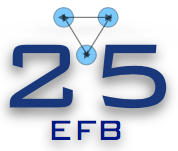Speaker
Description
With the experimental realization of strongly confined atomic and molecular systems using, for example, optical lattices or tweezers the modification of the few-body physics due to tight confinement is of increasing importance, since the interaction and confinement lengths
can become comparable in these systems. The physics may fundamentally change, if the confinement leads to effectively reduced dimensionality. Open channels describing asymptotically free particles become formally closed leading to a modification of resonance positions. This effect is also relevant, if, e.g., a confining potential is artificially introduced in order to numerically treat nuclear systems adopting bound-state approaches.
Furthermore, new types of resonances, so called confinement-induced resonances (CIRs) can occur. These come in two flavours: elastic CIRs that occur for a unique ratio between scattering and confinement lenghts, and an in principle infinite series of inelastic CIRs. While the former are limited to (quasi) one- and two-dimensional geometries, the latter occur in all dimensions and have very recently also experimentally been observed under three-dimensional confinement. The occurrence of CIRs is not limited to ultracold atoms or molecules, but is also predicted for, e.g., electrons or excitons in quantum dots, the latter system allowing for on-demand single-photon sources.
Another interesting aspect of confined few-body systems arises, if the confining potential allows for tunneling. The study of the tunneling dynamics of (periodically) driven few-body systems like ultracold atoms in optical tweezers may even serve as a quantum simulator for simulating the behaviour of atoms and molecules in intense ultrashort laser pulses ("attosecond physics in slow motion").

